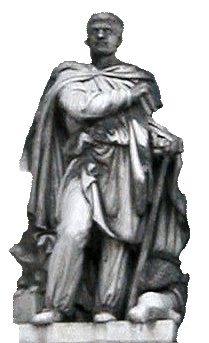Pytheas, a poor man, is an astronomer at the city observatory. After measuring the tilt of the earth and the latitude of Marseille, he observes the celestial north pole, and convinces the assembly of Timuks to finance an expedition to the north. He will thus be able to confirm his observations.
We know very little about the man. He is simply "a poor man". This is how Polybius sees him (A1).
Pytheas is a Massaliote, a man of the people, born during the 4th century BC. He is therefore a contemporary of Aristotle and Alexander the Great. He probably holds the position of astronomer at the Marseille observatory. This essentially consists of a gnomon. It is an obelisk, like the one that can be seen at the Mazargues roundabout. It is perhaps twenty cubits high (10 m). With this gnomon, Pytheas measures the shadows cast by the sun.
Astronomy is a science of long-term observation. The gnomon may have been installed before him and it uses the work left by his predecessors. The device is installed on a flat, horizontal surface, of large dimensions, oriented east-west, six to eight times its height, or sixty to eighty meters. This allows shadows to be measured early in the morning and late in the evening. The direction of the north is traced on the ground, as well as the main curves of the shadow depending on the day. Where is it installed? Towards the beginning of Lacydon, at the foot of the St Laurent hill, or on the hill itself? Or perhaps also outside the city walls? (We don't believe it much). We have a preference for the esplanade de la Major (if the land was flat at that time).
Pytheas is, in particular, responsible for telling the time to his fellow citizens. The changes of season are identified as follows: At the spring and autumn equinoxes, the tip of the gnomon's shadow describes a straight line during its movement. At the summer solstice, the shadow is shortest at noon, while at the winter solstice it is longest. Pytheas measures a length of 111, on the equinox day, for a total height of the gnomon of 120. A simple trigonometric conversion would have been enough for him to give the latitude in degrees: Arctg(111/120)=43°. But he does not know, at this time, the trigonometric functions, nor even the decimal numbers. It will therefore be necessary for him to transform this measurement into a fraction of circumference. But this conversion is not known.
Another measurement, which is attributed to him, is that of the obliquity of the ecliptic, inclination that the axis of the earth makes with its plane of rotation around the sun. He found 11/166 of circumference, or 23°53'. It is Eratosthenes who reports this measurement. As he did not go to Marseille for his geography of the world, he therefore used Pytheas' measurements.
Our man is an excellent observer. At night, turning towards the north, he sees that the stars revolve around the celestial pole. Hipparchus tells us: "there is no particular star at the pole, but an empty space close to three stars. The point marking the pole forms a quadrilateral with the three stars, - in fact, exactly as Pytheas described it." (A and K of the dragon and B of the little bear). Today, the north celestial pole is located very close to the polar star in the little bear. This is because the axis of rotation of the earth describes a cone of about 23° in a period of 26,000 years. Hipparchus, again, reports this observation to us. He will later discover the precession of the equinoxes.
Pytheas now has all the possible data on Marseilles. He knows that the earth is round. He has probably heard vague stories about the northern lands, reported by the caravaners. He knows from his observations that towards the north the sun must no longer set in summer, and he has an obsession: to evaluate the circumference of the earth. He also knows that by starting from the Pillars of Hercules, and and sailing constantly towards the west, one must reach the Indus River. In this context, the first estimates imply a journey that is far too long.
 |
Statue of Pytheas on the facade of the Marseille Chamber of Commerce (La Cannebière) |
He will leave for the edge of Europe.
.

